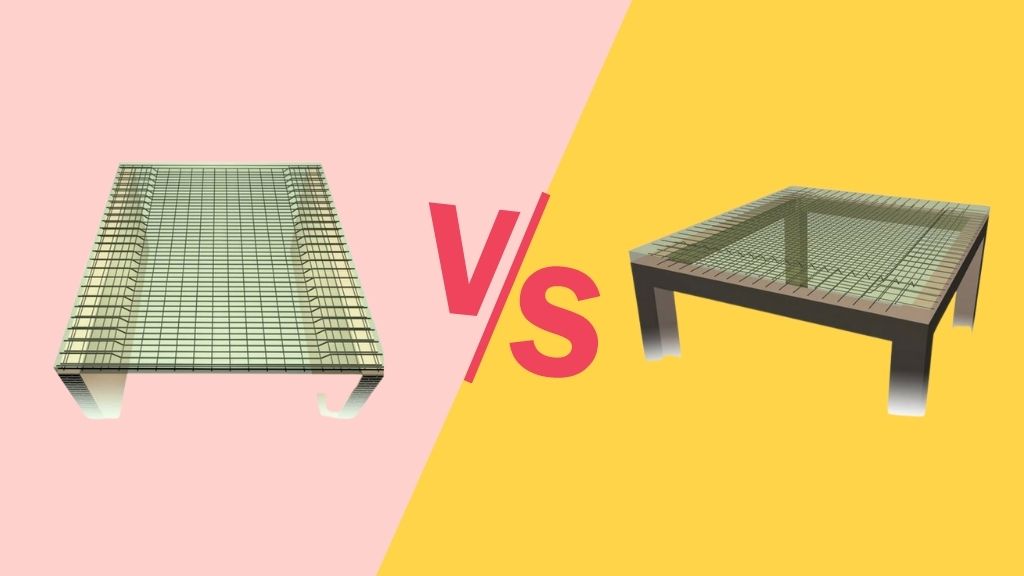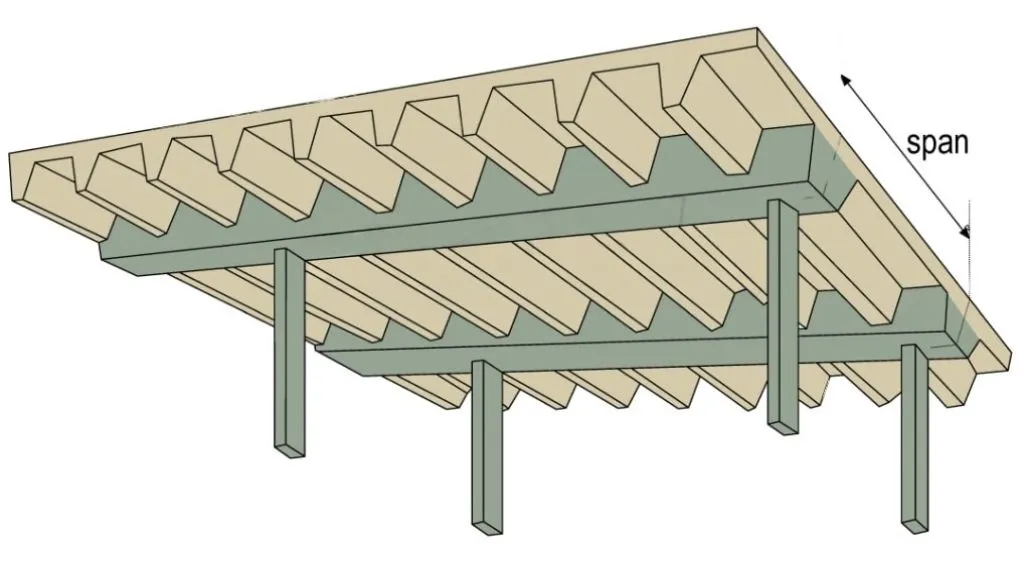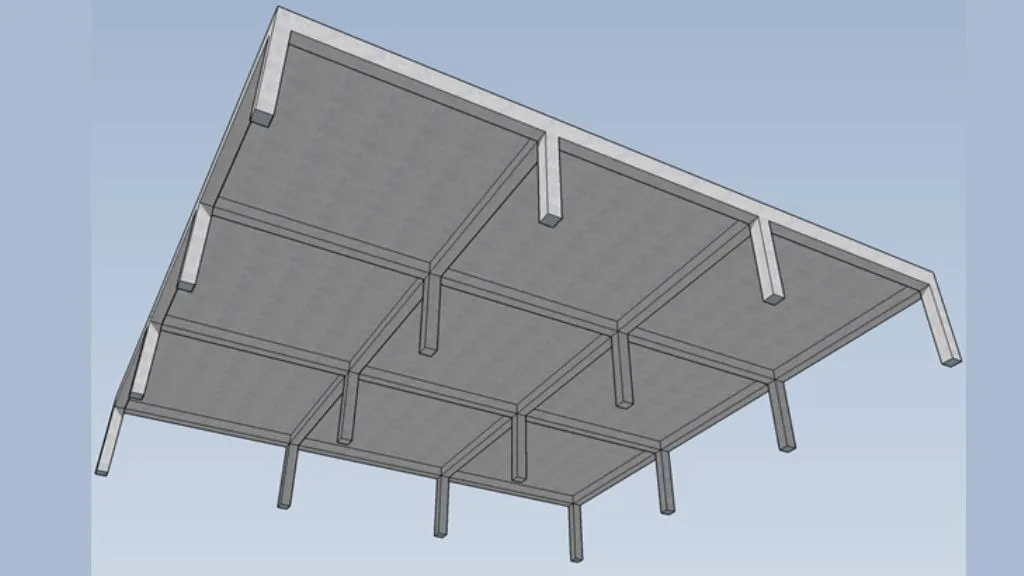
Difference Between One-Way and Two-Way Slabs
In structural engineering, where the minutest details can determine a building’s integrity, slabs play a pivotal role. These horizontal, flat surfaces, typically composed of concrete or other durable materials, provide the foundation for ceilings, floors, and exterior paving. Among the various types of slabs, one-way and two-way slabs stand out as critical structural elements, each with its own set of characteristics and applications.
Before we get into the difference between one-way slab and two-way slab, you should know that there are 5 types of slabs:
- Flat slab
- Oneway slab
- Waffle slabs or grid slabs
- Two-way slab
- Circular slab
What is One-Way Slab?

Slabs that have only two rigid supports on either side, carry the load on them by flexure in a perpendicular direction to the rigid supports. When a slab is predominantly loaded uniformly, its plane surface distorts into a cylindrical surface. The curvature and the need for the cylindrical surface develop only in one direction. Such slabs are named oneway slabs.
Oneway slabs essentially act as shallow beams having a large width. Slabs that are supported on all 4 sides also behave as a oneway slab if the ratio of their span from longer to shorter is greater than 2 (according to IS 456:2000).
What is Two-Way Slab?

Some slabs receive support on all 4 edges and bear the load by flexure in 2 perpendicular paths, instead of one. They have less than two longer to shorter span ratios and are called two-way slabs.
Two-Way Slab and One-Way Slab: How to Calculate Them?
Here are the steps to calculate one-way and two-way slabs:
L/b (longer span/shorter span) < 2
- If the ratio of their span from longer to shorter is made greater than or equal to 2 then, the slab is regarded as a one-way slab.
L/b (longer span/shorter span) ≥ 2
- On the other hand, if the ratio of their span from longer to shorter is made less than 2, the slab is regarded as a two-way slab.
Difference Between One-Way Slab and Two-Way Slab
There are several difference between one-way and two-way slab. Let’s look at those:
1. Longer to Shorter Span Ratio (L/b):
Oneway Slab
- With a longer span to shorter span ratio greater than or equal to two (L/b ≥ 2), oneway slabs typically exhibit a clear dominance of one principal span over the other. This design choice reflects an intentional emphasis on maximizing the efficiency of a structure in one primary direction.
Twoway Slab
- The L/b ratio of less than 2 in twoway slabs signifies a more equitable distribution of spans. This design choice is often adopted to enhance the structural integrity and load-carrying capacity in both directions, accommodating a more versatile range of loading scenarios.
2. Bending Direction:
Oneway Slab
- Bending is confined to the shorter span, reflecting a unidirectional load-carrying behavior. This design is suitable for scenarios where loads predominantly act in a single direction, such as in narrow corridors or elongated structures.
Twoway Slab
- Bending occurs in both directions, accommodating bidirectional loading conditions. This design is advantageous in areas where the loads act in multiple directions, providing a more versatile and adaptable structural response.
3. Reinforcement Configuration:
Oneway Slab
- The concentration of main reinforcement in the shorter spans is a deliberate choice to address the primary bending direction. Distribution reinforcement in longer spans serves to augment the load-carrying capacity without over-reinforcing in one direction.
Twoway Slab
- The main reinforcement is distributed in both directions to fortify the slab against bending in both spans. This design ensures a balanced and comprehensive reinforcement scheme, enhancing the slab’s overall strength and performance.
4. Crank Orientation:
Oneway Slab
- The presence of cranks in two directions, often associated with the shorter span, helps mitigate the effects of negative bending moments. This design choice aims to enhance the structural performance in the primary loadbearing direction.
Twoway Slab
- Cranks are provided in all four directions, offering a symmetrical response to bending moments in both span directions. This approach ensures uniformity in load distribution and structural behavior.
5. Beam Support:
Oneway Slab
- Beam support on two opposing sides provides an efficient means of transferring loads from the slab to the supporting structure. This design choice is well-suited for structures with predominant unidirectional loading.
Twoway Slab
- Beam support on all four sides ensures comprehensive load distribution, offering stability and support in both principal directions. This design is particularly advantageous for structures with bidirectional loading conditions.
6. Load Distribution:
Oneway Slab
- Load is predominantly sustained in a single direction within the shorter span, aligning with the unidirectional bending behavior of the slab.
Twoway Slab
- Load distribution occurs in both directions, accommodating bidirectional loading scenarios. This design flexibility is essential for structures where loads vary in direction.
7. Deflected Shape:
Oneway Slab:
- After bending, the deflected shape of a oneway slab takes on a cylindrical form. This characteristic shape is a result of the unidirectional bending behavior and is crucial for assessing the slab’s performance and deformation under loads.
Twoway Slab
- The deformed shape of a two-way slab resembles a saucer or dish, reflecting the bidirectional bending behavior. This shape indicates the slab’s ability to distribute loads effectively in both directions.
8. Examples:
Oneway Slab
- Varanda and Chajja serve as practical examples of oneway slabs in various architectural applications. Their usage is often dictated by the need for unidirectional load-carrying efficiency.
Twoway Slab
- Constructive floors in multistory buildings exemplify the application of twoway slabs. These structures require the flexibility to handle bidirectional loads efficiently, making two-way slabs a suitable choice.
9. Steel Amount and Thickness:
Oneway Slab
- The relatively lower amount of steel in oneway slabs necessitates increased depth and thickness to meet structural requirements. This design choice aims to provide the necessary strength and stability for unidirectional spans.
Twoway Slab
- With a higher steel content, twoway slabs can achieve comparable strength with decreased depth and thickness. This design optimization allows for more efficient material usage and cost-effectiveness while maintaining structural integrity.
10. Economical Span:
Oneway Slab
- Economically viable for spans up to 3.6 meters, oneway slabs are well-suited for smallerscale structures where unidirectional load-carrying efficiency is paramount.
Twoway Slab
- Economical benefits for panel sizes up to 6m ✕ 6m make two-way slabs suitable for larger structures and applications where bidirectional load distribution is essential. The increased panel size allows for efficient use of materials and construction resources.
- These are the differences between one-way and two-way slabs. Now, let’s look at the reinforcement details.
One-Way and Two-Way Slab: Reinforcement Details
1. Reinforcement Details of Oneway Slab
Suppose, we take a slab measuring 4m in breadth and 10m in length. Then,
L/B = 10/4 = 2.5 ≥ 2
It is clear from the above example that the L/B ratio is greater than 2, making it a one-way slab. The distribution bars are provided in a longer span while the cranked bars or main bars are provided in a shorter span.
2. Reinforcement Details of Twoway Slab
Let’s take a slab measuring 6m in breadth and 6m in length. Then,
L/B = 6/6 = 1 < 2
It is clear from the example taken that its L/B ratio is less than 2, making it a two-way slab. Here the cranked bars or main bars are provided at a shorter span as well as a longer span too.
The Bottom Line
The differences between one-way and two-way slabs are substantial and should be carefully considered in the planning and design phases of construction projects. The unique structural actions, load transmission patterns, steel content, and applications of these slabs make each suitable for specific scenarios. Before embarking on a construction endeavor, a thorough analysis of requirements, loading conditions, and other pertinent factors is imperative.
Whether it’s the economic efficiency of one-way slabs in smaller panel sizes or the versatility of two-way slabs in larger structural designs, understanding the nuances of these structural elements is crucial. In the ever-evolving field of structural engineering, informed decision-making paves the way for resilient and enduring constructions. And for those delving into the intricacies of load calculations for two-way slabs, tools like Tribby3d can be invaluable, ensuring precision and accuracy in the design process.






